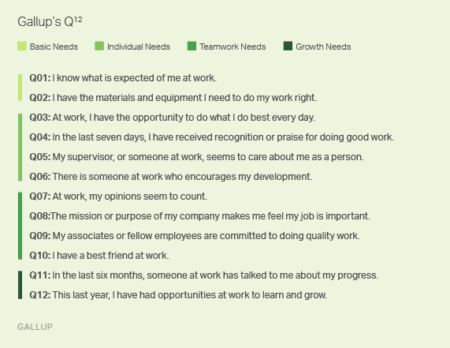And How Can You Improve It?
Employee engagement is a term you probably hear all the time. A quick Google search pulls up over 34 billion results, and the latest research warns that only 49 percent of employees are engaged at work.
So while we know engagement is important (leading to higher service quality, customer satisfaction and profitability), it’s not always clear what changes should be made to improve it.
Defining Employee Engagement
To start, it’s important to note that employee engagement is not the same thing as happiness or satisfaction. Being happy and satisfied at work is good, but it doesn’t necessarily translate to employees working hard and going the extra mile on behalf of the company.
Rather, employee engagement represents the emotional commitment an employee has to the organization, which involves a certain level of:
- passion
- motivation
- involvement
- discretionary effort
When employees are engaged, they care more about their company and work harder to help the company achieve (or even exceed) its goals. This means employees put in discretionary effort, or go above and beyond without being asked. They put in that extra time because they truly believe in what they are doing and want to see the company succeed.
Breaking It Down into Actionable Levels
Similar to Maslow’s Hierarchy of Needs, you can think of employee engagement as something that develops as certain needs are met. Bain & Company research laid out the following pyramid to describe the ultimate level of “inspired employees.”
At the very basic level employees:
- have a safe work environment
- have the training, tools, and resources to do their jobs well
- can get their jobs done efficiency without excess bureaucracy
- are valued and rewarded fairly
The next level sees employees that:
- are part of an extraordinary team
- have autonomy to do their jobs
- learn and grow every day
- make a difference and make an impact
And at the top, you have employees who:
- get meaning and inspiration from their company’s mission
- are inspired by the leaders at their company
Another helpful way to break down the path to engagement is to look at different groups of needs. Gallup uses the categories basic, individual, team, and growth to understand employee engagement rates in the US. The 12 questions below paint a similar picture of engagement to the Bain & Company pyramid.

Making a Real Difference
Many companies think the way to boost engagement is to pay employees more. But as you can see from the pyramid, being paid fairly sits at the bottom – it’s not a game-changer for engagement. To foster real engagement, you have to go beyond the paycheck.
The difference among engaged employees is that they have the freedom to do their jobs, grow their skills, and make a difference. They feel a strong sense of purpose and know they are making an impact — something that’s increasingly important for the millennial generation.
Having a workforce that feels this way doesn’t happen out of thin air, but comes from a commitment to communication and culture. The company culture should be one that motivates, empowers, challenges, and respects all employees.
Leadership should always keep employees in the loop so they have a clear connection to the company’s mission, know where the company is heading, and understand how they contribute to organizational goals.
How companies go about communicating this big picture is very important. Quarterly or annual “all hands” meetings simply aren’t frequent enough, and emails and newsletters go unread. Technology can facilitate regular top-down communication that keeps workers connected and engaged, via the mobile devices they already have.
Whether it’s sharing an engaging video from the CEO, relaying a new operating procedure to the entire company, or sending an important safety alert — transparent, real-time communication is key for reaching high levels of employee engagement.


Share this: